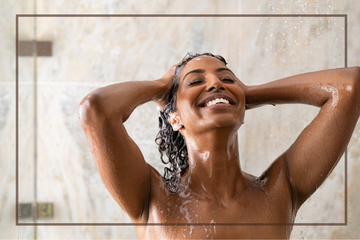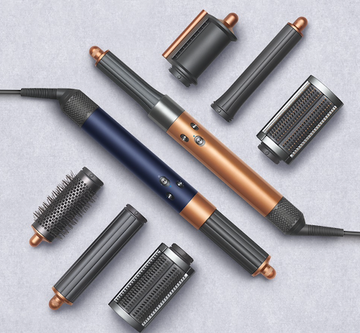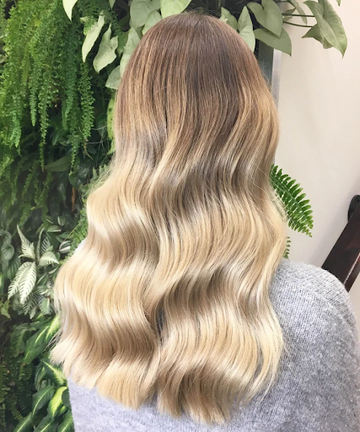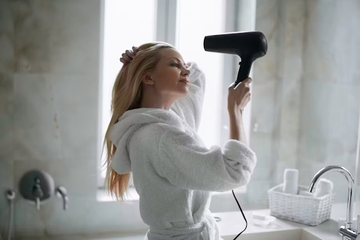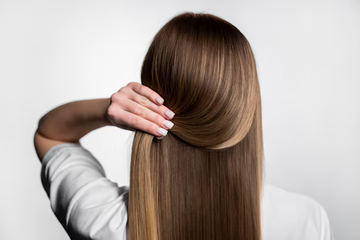Blog Summary:
Quick overview of key takeaways:
- Hot water deep-cleans oil and buildup but can strip natural oils and irritate the scalp if too hot.
- Cold water smooths cuticles and helps retain moisture but won’t remove buildup well on its own.
- Aim for ~100°F / 37°C (lukewarm) for the wash to balance cleansing and hair/scalp health.
- Best routine for most: wash warm, then finish with a brief cool rinse; consider a filter or clarifier if you have hard water.
When it comes to washing your hair, many of us focus on choosing the right shampoo and conditioner, but there's another crucial factor that often gets overlooked: water temperature.
The temperature of the water you use can significantly impact the health, shine, and overall appearance of your hair. So, should you choose a cold water rinse for your hair? Or is hot water a healthier choice?
Below, we answer these questions and more to help you understand how different temperatures affect your hair and how to care for your hair well overall.
The Difference Between Hot and Cold
Both hot and cold water impacts hair health in unique ways, so it is important to find a healthy balance.
Hot water is able to provide a deep cleanse, disintegrating dirt and oil, while cold water smooths hair cuticles and helps your hair retain moisture.
The truth is that both have a place when it comes to hair care. The secret to water temperature is moderation.
According to experts, the best water temperature for your hair is around 100°F or about 37°C. This is just above our normal body temperature. This is the perfect temperature for getting a cleansing wash, without compromising your hair and scalp.
If your water temperature is too high, you run the risk of destroying the keratin and lipid bonds on your hair cuticles. In other words, you get frizz. But if the water temperature is too low, you will have a harder time getting your hair and scalp clean, because cold water is not able to thoroughly break down the product buildup and oils on your hair.
Love a Hot Shower?
Honestly, so do we! Taking a hot shower has a lot of health benefits and overall, it's incredibly relaxing.
Although, when it comes to your hair’s health, a too-hot shower can irritate or even damage your scalp. With a damaged scalp, you become more vulnerable to factors that can irritate it, such as styling products and dandruff causing microbes.
Your scalp isn’t the only thing that can become damaged in a hot shower. In water temperatures above 100°F, you run the risk of stripping your hair of its natural oils and in turn leaving your hair looking dull, lifeless and frizzy.
What about a Cold Shower?
Just like hot showers, cold showers are known to have a lot of health benefits as well.
While there are many pros to taking cold showers, there are also some cons.
So, is a hair wash with cold water a good idea? Well, cold showers are known to decrease your hair volume. The temperature is great for helping your hair retain moisture, but an excess amount of moisture can make your hair look flat and sometimes oily. This is because the cold water is not able to break down the sebum and product buildup in our hair.
Instead of the oils liquifying and washing away, like they do in hot water, cold water keeps the oils in a solidified state, making it harder to clean.
So What Do We Recommend?
If you’re anything like us, you don’t want to just stop taking hot showers all together and that’s understandable.
So to get that relaxing, hot shower while also keeping your hair safe, we recommend creating a hair washing routine that uses both hot and cold water.
So wash your hair like you normally would, starting with warm or hot water. This is what will get your scalp and hair squeaky clean, melting away buildup and oils. Then, once your hair is clean, you can apply your conditioner treatment(s) and rinse those using cold water. This will ensure that your hair soaks up and retains that moisture by smoothing the hair cuticles, and in turn, reducing frizz.
A Tidbit on Water Quality
I’m sure you’ve heard it before, but water quality has a big impact on our hair’s health. If you live in an environment that has hard water, you should be aware of the damage it can cause to your hair.
Hard water has a tendency to leave a film on your hair, causing dry and brittle hair over time. It is also known to increase hair shedding, leaving your hair looking thin and dull or even brassy.
A quick solution to prevent hair exposure to hard water, consider buying a shower head filter. You can also look into buying clarifying hair products, such as shampoos, conditioners, rinses, etc.
Just Remember…
Like anything else, moderation is key. You don’t have to take cold showers for the rest of your life for healthy hair. But you don’t have to give them up either if they’re your thing! We recommend either rinsing hair with hot water and then cold water in the shower, or washing at a temperature of around 100°F or about 37°C if you can.
Everyone’s hair is different and has different needs, so if you are unsure how to best protect your hair when showering, reach out to a trusted stylist and seek their advice. Much love!
🖤 TYME
FAQs:
Is it better to wash hair in hot or cold water?
It’s not really about choosing one or the other—it’s about how and when you use them. Hotter water helps break down oil and buildup, while cooler water helps lock in shine and smooth the cuticle. The healthiest approach is usually to start with comfortably warm water for cleansing, and finish with a quick cool rinse to seal in moisture.
What temperature is best to wash your hair?
Experts recommend sticking close to body temperature or around 100°F / 37°C. That’s warm enough to cleanse effectively but not so hot that it strips your scalp or causes frizz. If you like hotter showers, try keeping your hair under the spray for less time at those higher temps and switching back to lukewarm for most of the wash.
Is cold or warm better for your hair?
Warm water is best for washing because it effectively removes dirt and oil. Cold water is best for finishing because it helps lock in moisture. The ideal routine uses both: wash with warm, finish with cold. Overall, lukewarm water (around 100 degrees) is best.

